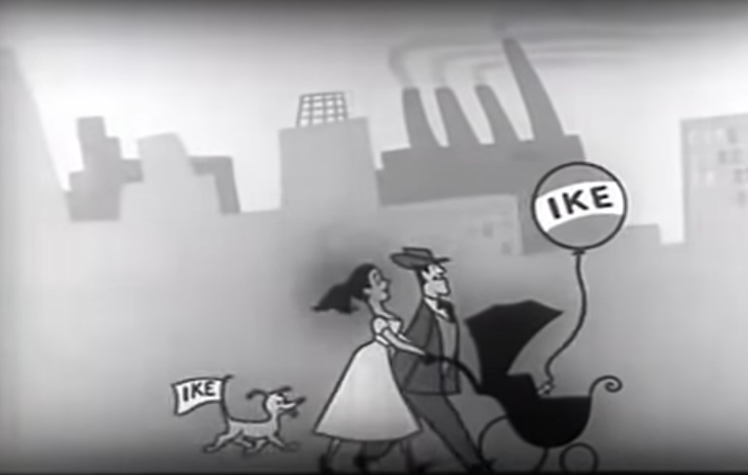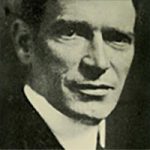After “I Like Ike”, Political Parties Were Never the Same

In 1952, an ad endorsing Dwight D. Eisenhower for president made history as the first televised political commercial. Now legendary, the “I Like Ike” ad was not paid for by the National Republican Committee but by “Citizens for Eisenhower.”
Though the ad contained the donkey and elephant symbols of the two major parties, the word Republican never appears in it.
It was unsophisticated by today’s standards, a simple, black-and-white cartoon with a corny but catchy song, Yet it began the era of individualized, candidate-centered campaigns. It also helped lead to a nearly 70-year decline in the political party system, both at the national and state levels, including New Jersey.
Previous columns have focused on the role independent groups have played in contributing to the weakened party system.
The eye-popping growth in independent expenditures has been fueled by the enactment of the Bipartisan Campaign Reform Act (BCRA) in 2002 and the U.S. Supreme Court decision Citizens United in 2010.
Undoubtedly, independent, dark money groups have contributed to the demise of the party system. At home, dark money organizations spent $47.5 million during the 2017 legislative election only to be surpassed a year later when they spent $49 million attempting to influence the state’s congressional contests.
During the 12-year period 2005-2017, independent group spending increased almost 11,500 percent. Throughout the same period, party spending in New Jersey lagged far behind.
It is important to remember that the emergence of independent groups and the demise of the party system are closely linked. Yet, upon reflection, there is more to the decline of parties than merely the onset of independent spending.
In truth, the emergence of dark money groups, rather than being the cause, may be one of the consequences of party decline that began decades ago.
The erosion of the political party system traces back to Eisenhower’s simple, jingle-filled, cartoon-like political commercial.
Prior to the 1952 Eisenhower campaign, presidential campaigns were exclusively run by the two national parties. The “I Like Ike” ad paved the way for major changes in the way campaigns would be waged in the future.
During the 1960 presidential contest, individualized, candidate-centered campaigns reached a new level. For the first time a presidential debate was televised, increasing the importance of this relatively new technology.
The two candidates, John F. Kennedy and Richard M. Nixon, were brought into the living rooms of millions of Americans. American voters were now focused on the candidates as individuals rather than their political parties.
The impact was dramatic. Some pundits believe that the debates decided the election.
Interestingly, Richard Nixon would play a role in the furthering of individualized campaigns in both his 1968 and 1972 campaign.
Following his close loss in 1960, Nixon decided to run for governor of California in 1962. After losing to Pat Brown, Nixon held a press conference in which he lamented “you won’t have Nixon to kick around anymore, because gentlemen, this is my last conference.”
Six years later, however, the resilient Nixon would be elected President. As the result of his defeats in 1960 and 1962, he had learned a valuable lesson. In the new television age of individualizing campaigns, a candidate’s image was paramount.
John Kenneth White and Mathew R. Kerbel, in Party On, noted “Richard M. Nixon emulated Eisenhower’s approach in 1968 . . . using television to reinvent himself. . .”
In more ways than one, however, the 1968 election was eventful in terms of the furtherance of individualized, candidate-centered campaigns and party demise.
The fractured Democratic presidential campaign that ended in a chaotic convention in Chicago and the nomination of Hubert Humphrey as the Democratic candidate led to major reforms in 1972 and a landslide victory for President Nixon, both of which would hasten party decline.
In 1972, the McGovern-Fraser Commission reforms went into effect. The intent of the reforms was to prevent the party establishment from having control over selecting the presidential nominee, something reformers believed happened in 1968 with the selection of Humphrey.
The long-term result, however, was to create the modern primary system that has contributed to the weakening of the political party system and the promotion of individualized campaigns.
The 1972 landslide victory of Richard Nixon also undermined political parties and advanced the idea of individualized, candidate-centered campaigns.
In its efforts to accomplish the president’s reelection, the “Committee to Re-elect the President” focused solely on Nixon’s re-election at the expense of any effort to build up the Republican party or help lower-level Republican candidates.
Ultimately, the campaign would have as its offshoot Watergate, which would discourage candidates from running on the party label but more importantly usher in an era of campaign finance reforms and legal challenges, many of which would undermine the party system.
More recently, social media, like the advent of TV in the late 1940s and 50s, is taking its turn at striking a blow to the party system and furthering the trend toward individualized candidate-centered campaigns.
Obviously, President Donald Trump, during his campaign and presidency, has used social media expertly to personalize both his campaign and presidency. However, before him was Howard Dean, who ran a virtual internet campaign in 2004. Both, in their turn, have struck a blow to the parties.
But more than either the current President or former Governor of Vermont, the recent netroots challenge to the Democratic establishment and the Tea Party challenge to Republicans served the purposes of campaigns, either for Congress or President, that were candidate-centered and set part from the political party system.
The substantial and continued rise in independent expenditures has critically injured the political party system. This explosive growth was spurred by BCRA in 2002, facilitated by Citizens United in 2010, and in New Jersey, furthered by the Pay-to-Play law in 2006.
Without question, independent groups have been most consequential in weakening political parties and bringing less accountability and transparency to the process.
In truth, however, independent, dark money groups are not the cause but rather the most significant offshoot of an overall trend toward party decline that began nearly seven decades ago. That can only be partly reversed now by legislative reforms.
Parties may never again have the clout they did in 1952.
Jeff Brindle is the Executive Director of the New Jersey Election Law Enforcement Commission.
The opinions presented here are his own and not necessarily those of the Commission.






You can’t be serious. I wish I could convince myself that this article was a dark satirical joke. The “dark money”, as you call it, is what funnels into, and feeds, the two party system. The last thing that a true democratic republic should have is a domineering two party system with the unbridled, unchallenged ability to tell constituents to take it or leave it. Choice and voice are the cornerstones elected representation.